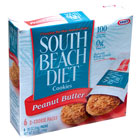

With a formula that qualifies for 0% saturated and trans fat listed on the Nutrition Facts panel, Gerber Product Co.’s new Graduates Crackers use “ultra low linolenic soybean oil” to reduce rancidity tendencies.
Research suggests that the correct balance of omega-3 and omega-6 fatty acids is beneficial to health. Soy and canola oils contain high levels of both. Monounsaturated fatty acids (MUFA) such as oleic acid may also lower cholesterol levels. MUFA can be found in most major vegetable oils, and it is especially prevalent in olive and canola oils.
Scientists will continue to delve into the complex issue of fats and health. At times, studies may provide information that flies in the face of commonly held assumptions. For example, in a January 2007 e-newsletter, Decision Media reported on research by Malin Haglund Garemo, a dietician from Gothenburg University in Sweden, indicating that a higher intake of fat was associated with lower body weight in children and that a higher BMI (body mass index) was associated with a higher sugar intake.

In baking, fats currently being used to replace hydrogenated oils which are high in trans fat include palm oil shortenings, animal fat-based shortenings, interesterified oils and oils using exotic catalysts for hydrogenation without the formation of trans isomers. The formulation of these South Beach Diet Cookies from Kraft Foods relies on high-oleic canola oil for help with a 0g trans fat label.
Removing Trans Still a Top Priority
“Food processors and foodservice operators face similar challenges in moving toward reduced-trans/no-trans solutions. They must try to keep the taste, texture and functionality that their customers expect of their brands, while often significantly modifying their formulations. In doing so, formulators can encounter several problems which are being solved by extensive testing of different combinations of ingredients,” states Frank Kincs, director of R&D at a well-known fat and oil supplier.“The biggest problem,” states Joe Higgs, vice president of R&D technology at a fat and oil supplier, “is in replacing structure provided by the solids in fat. Solids come from two sources, saturated fat and trans fat. When removing the trans, the saturates need to increase in order to maintain the structure of the fat. Another problem is that the end user wants a ‘drop in’ replacement product, exactly like what they had before. When blending different oils, it is necessary to formulate to an acceptable end product and not just try to match solid fat index (SFI) curve of the original fat. It is possible for two fats to have different SFI curves yet function the same with some modifications to the mixing and baking process.”
“In baking, fats currently being used to replace trans fat-containing hydrogenated oils include palm oil shortenings, animal fat-based shortenings, interesterified oils and trans-free hydrogenated oils, which are made using exotic catalysts for hydrogenation without the formation of trans isomers. There is also a high stearic soybean oil in development that will have some baking functionality but is still three to five years away,” states Richard Galloway, consultant to the United Soybean Board.
Manufacturers are also testing blends of liquid oils and fully saturated oils with no trans isomers as substitutes for trans-containing fats in margarines, spreads and shortening applications.
Frying Applications
“Frying fats are different from baking fats because ‘fry life’ is necessary. Unsaturated fats are more susceptible to breakdown, so keeping their level as low as possible is desirable for frying. This accounts for the growth in demand for high-oleic and low-linolenic oils such as high-oleic canola and sunflower, and low-linolenic canola and soybean oils. These oils are becoming a popular alternative to partially hydrogenated fats for frying,” contributes Higgs.“An option for frying is to reduce the linolenic content. Linolenic acid contains three double bonds and is the most unstable of the common fatty acids,” states Higgs. “Low-linolenic oils are available in soybean and canola oils. In addition, ‘mid-oleic oils’ are low in linolenic and have reduced linoleic (two double bonds) to increase stability and are currently available in sunflower oil. A mid-oleic soybean oil is currently being developed,” he adds.
“Low-linolenic soy oil can replace trans fat in lighter duty frying applications, as it has excellent flavor stability and resists oxidation without hydrogenation,” explains Galloway. Many applications that previously required lightly hydrogenated oils can achieve equal functionality with low-linolenic soybean oil, as seen, for example, in Kentucky Fried Chicken (KFC) and Kellogg’s products. KFC announced a switch to low-linolenic soybean oil for frying in all of its 5,500 U.S. restaurants. Since the switch, KFC’s products, including Original Recipe and Extra Crispy chicken, contain 0g of trans fat per serving.
Interesterified Oils
A variety of products have been commercialized using enzymatically interesterified domestic blends of soybean oil and hydrogenated soybean oil as well as 95% palm kernel oil produced using immobilized lipase technology. These materials are used as margarine, spread and shortening-based stocks. The domestic products are typically made by enzymatically interesterifying a blend of soybean oil with fully hydrogenated soybean oil. By varying the level of fully hydrogenated oil (hardstock), the melting and functional characteristics of the fat can be modified, contributes Tom Tiffany, senior marketing manager at a fat and oil supplier.Tiffany continues, “Enzymatic interesterified shortenings and margarines utilizing soybean oil and fully hydrogenated soybean oil tend to be rich in stearic, omega-6 and omega-3 fatty acids. The American Heart Association has indicated that stearic acid may not affect or may even lower blood cholesterol. When soybean oil is used as the liquid portion of the blend, the levels of omega-3 and omega-6 fatty acids are also increased, compared to palm oil or partially hydrogenated vegetable oils used for similar applications.” He adds, “FDA has stated that when foods are formulated with interesterified soybean oil, the descriptor ‘interesterified soybean oil’ can be used in the ingredient statement.”
Other Oils
In deciding upon a type of oil to use in a formulation, the fatty acid composition plays a role in the oxidative stability of the food. Oils with high levels of polyunsaturated fatty acids are more prone to develop off-flavors. Other considerations include nutritional profiles and labeling.“Canola oil is low in saturated fats, and when used in the right amounts by food manufacturers, the product may qualify for a health claim involving saturated fat. High-oleic canola oils provide good shelflife without hydrogenation. They can be two and a half to three times as stable as traditional soy or canola oils. They are often used in fryers and as spray oils,” adds Kincs.
“Some of the reasons a manufacturer would choose soy oil over other oils is that soybean oil provides a broader range of flavor-neutral functionality than either corn or olive oil. Canola oil suffers more from light-duty frying than does soybean oil. And from a sheer volume standpoint, soybean oil production in the U.S. exceeds all other edible vegetable oil production by about three-to-one,” explains Galloway.

Manufacturers are experimenting with margarines, spreads and shortening applications by substituting trans-containing fats for blends of fully saturated oils with no trans isomers and liquid oils.
Butter
“Of course, butter came before all of the customized vegetable fats used today. Butter has its own unique functions that have been mimicked through the development of shortenings and margarines. Butter provides different characteristics than other fats. For instance, butter provides flakiness to pastry and tenderness to cookies. Poundcake has a ‘melt in your mouth’ quality because of butter. Also, butter provides a buttery flavor to all baked products it is used in. Butter does have a shorter shelflife and less flavor stability than some fats and oils. It also needs to be stored at refrigerated temperatures and sometimes tempered before use. Butter has a premium image in food products like baked goods, confections, sauces and entrées, and also has better label appeal than hydrogenated and other processed fats,” notes Kimberlee Burrington, dairy ingredient applications coordinator at the Wisconsin Center for Dairy Research.“Butter is also evolving into different products to meet the need of manufacturers. New technologies include fractionation, which has been researched extensively and commercialized by New Zealand and European companies,” adds Kathy Nelson, applications lab coordinator at the Wisconsin Center for Dairy Research. “A lot of work was done at the [center], but no U.S. companies have commercialized customized butters using this technology. Partially, this is because butter has maintained a very high price in the market, so it has not made economical sense to add more value to butter by customizing it.”
Butter blends with margarines can be a good consideration for certain applications, because they can be customized to provide specific functionality and flavor.
Other Oil Topics
“We are working on several oil products under the category of more healthful oils that are not only reduced in trans fat but actually have improved nutritional profiles. One example is a vegetable oil produced from a proprietary process. It is metabolized by the human body more rapidly than traditional vegetable oils and actually inhibits the body’s ability to absorb cholesterol. These attributes combine to present a vegetable oil that helps maintain the desired weight and lower LDL cholesterol, when used as a replacement for traditional cooking oils,” adds Kincs.
“Reducing saturated fat in trans-free products is a big issue and most difficult to fix,” explains Higgs. In addition, there are genetically modified organism (GMO) issues in a lot of the new oils, because they are GM or contain a genetically modified trait like Roundup Ready.”
“Another current project is to modify the partial hydrogenation process to produce low-trans alternatives. Work is being done with process variation to minimize trans formations with enough reduction in C18:3 to create an oil with decent oxidative stability. The oils can then be used in blends to provide the end user a product based on commodities such as soybean oil,” adds Tiffany.
“Suppliers are offering customized blends of oils to achieve food processor functionality and nutritional requirements. Traditional oils, identity-preserved oils such as low-linolenic and high-oleic soybean and canola oils, palm oil, palm kernel oil, animal fat options and interesterified oils comprise some of the offerings,” contributes Kincs.
To address a further nutritional need, a vegetable oil that contains iodine has been developed. Suppliers promise that more innovations are on the way, but they cannot share any more information publicly at this time...stay tuned for more news.